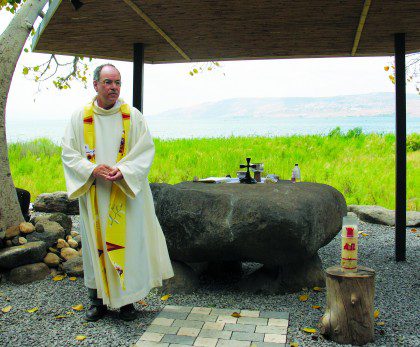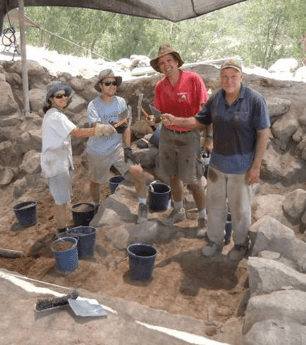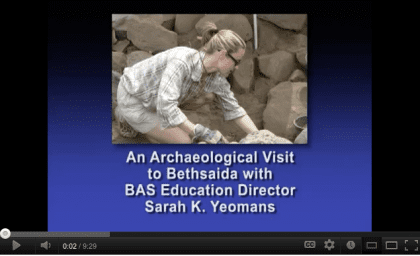
A hands-on connection to the life of Jesus
Much can be learned about a place through books, class work and the shared impressions of others. This is how most people come to know of the Holy Land, about the life of Jesus and his first disciples.
“But to actually get the same dirt on your shoes that Jesus or King David may have walked in; there is something powerful in that,” said Fr. Charles Brown, SCJ, an assistant professor of Scripture Studies at SHST. “It is a visceral connection that roots you to the Holy Land in a significant way.”
Last June, Dr. Patrick Russell, Sacred Heart School of Theology’s vice president for academic affairs, had the opportunity to make that connection for the first time. “We read about Biblical history, but this was a way to actually touch it,” he said.
Dr. Russell took part in the Bethsaida Archeology Project, just north of the Sea of Galilee. Operated by an international consortium of colleges and universities, the project gives participants the opportunity to take part in and learn the skills of an archaeological excavation.
“He came back incredibly energized by the experience,” said Fr. Brown. “His enthusiasm grabbed me.”
During the past year SHST faculty informally discussed ways of giving their seminarians a hands-on experience of Israel.
“Initially, we thought of a pilgrimage,” said Fr. Brown.
But for some time Dr. Russell had wanted to take part in an archeological dig. “It was a hole in my academic training,” he said.
The Bethsaida project is located in what is called the “Gospel Triangle,” in the heart of where Jesus’ life and much of Biblical history took place. Established in the 10th century, BCE, the area underwent several conquests and occupations.
Herod the Great is said to have settled the area and the main business of the village was fishing (“Bethsaida” means “House of Fishermen”). Hundreds of fishing implements have been found at the site.
Tradition has it that this is the village where many of the early disciples of Jesus were born and raised, including Peter, Andrew, Philip and perhaps the Zebedee brothers. It is a place where Jesus spent time, and with the backdrop of the fishing industry, it is easy to relate to his call that his disciples be “fishers of men.”
“Bethsaida is the third most frequently mentioned city in the Gospels,” said Fr. Brown.
When it was established, Bethsaida was on the banks of the Sea of Galilee, yet the current location is over a mile inland. Researchers believe that earthquakes and resulting landslides reshaped the shoreline, moving it away from the village. Dependent on fishing, Bethsaida’s population is thought to have relocated to the shore in about the 4th century.
“The fact that it was abandoned in the 4th century means that much has been preserved and is accessible,” said Fr. Brown. Archeologists do not have to sift through centuries of development to find artifacts from the time of Jesus.

One of Dr. Russell’s most profound moments during his time with the dig was “when I found a Roman nail that was of the same type, made at the same time, as the ones that were used to nail Jesus to the cross,” he said. “To hold that in my hand and have such a tangible link to Jesus’ life… I felt such a strong connection to the cross.”
“It is the experience of the ‘Fifth Gospel,” said Fr. Brown, referring to a concept developed by a Benedictine priest, Fr. Bargil Pixner.
“Five gospels record the life of Jesus,” wrote Fr. Pixner in his book With Jesus Through Galilee: According to the Fifth Gospel. “Four you will find in books and one you will find in the land they call holy. Read the fifth gospel and the world of the four will open to you.”
“That’s what we want to offer to our students,” said Fr. Brown, “a hands-on experience of the Holy Land.”
With a substantial financial gift from a benefactor, Sacred Heart School of Theology recently made a three-year commitment to be a part of the consortium of nine schools that operates the dig. In doing so, Sacred Heart becomes the only Roman Catholic seminary in North America to sponsor an archeological dig in the Holy Land. It is also the “franchise” operator of the dig for the upper Midwest. Students from other universities can take part in the program, but they will have to go through SHST to apply for and to earn credit hours.
Students can earn six credits in Scripture through their participation in the ten-day program at the dig, or audit the session. Besides the dig itself, students will also have the opportunity to visit other Holy Land sites such as Megiddo, Jericho, Masada, Capernaum, Nazareth, Arbel and Tiberias. Locations differ with each session.
Sacred Heart School of Theology is starting small in its first year with several students from the seminary, as well as two SCJs in formation. Joining them will be Fr. Brown and Dr. Russell. They will take part in the June 16 – July 4, 2013, session joining participants from other member institutions.
In November, the last of the SHST spots for 2013 were filled. However, starting in 2014, the seminary would like to open the program to SCJs throughout the world and perhaps expand its participation to several of the summer sessions.
“We are very excited,” Fr. Brown said, “this new project is a marvelous fulfillment of our goals as a seminary. It also fulfills the desire of Fr. Leo Dehon, our founder, to train men in the theological and other human sciences for effective priestly ministry in the heart of modern societies.”
“Our students are so energized about the project,” said Br. Duane Lemke, SCJ, province formation director. “They realize that they get to walk the road and sift through their hands the actual soil walked on by the Savior. Their Dehonian vocation is to seek and announce the presence of Jesus by our lives. Finding Christ on the streets of the world, even an ancient street, is the SCJ Rule of Life.”
As noted, the Bethsaida Archaeology Project belongs to a consortium of schools, all with equal voice, but it is administered by the University of Nebraska, Omaha. Dr. Rami Arav, a faculty member in the Department of History and the Department of Philosophy and Religion at UNO, is director of excavations. He is credited with discovering, during a 1987 probe, evidence that lead to the widespread assertion that the site is indeed that of the Biblical Bethsaida.
“This is an on-going exploration,” said Fr. Brown. Students are not just visiting an archeology site, they are a part of “real” historical research. Members of the consortium have the first option to research artifacts found at the site. Each year leads to more discovery about the people of the area, people who were a part of the life of Jesus.
“It’s an incredible opportunity,” added Fr. Brown, who is chairperson of the SHST Bethsaida Archeology Project.
For more information:
For information about future summer programs, contact Fr. Brown at cbrown@shst.edu. As noted, the 2013 session is now filled, but the seminary will soon accept applicants for 2014.
Click here to visit the Bethsaida Archeology Project website.
Click on the video below to take a virtual tour of Bethsaida and meet some of the archaeologists and volunteer excavators.


